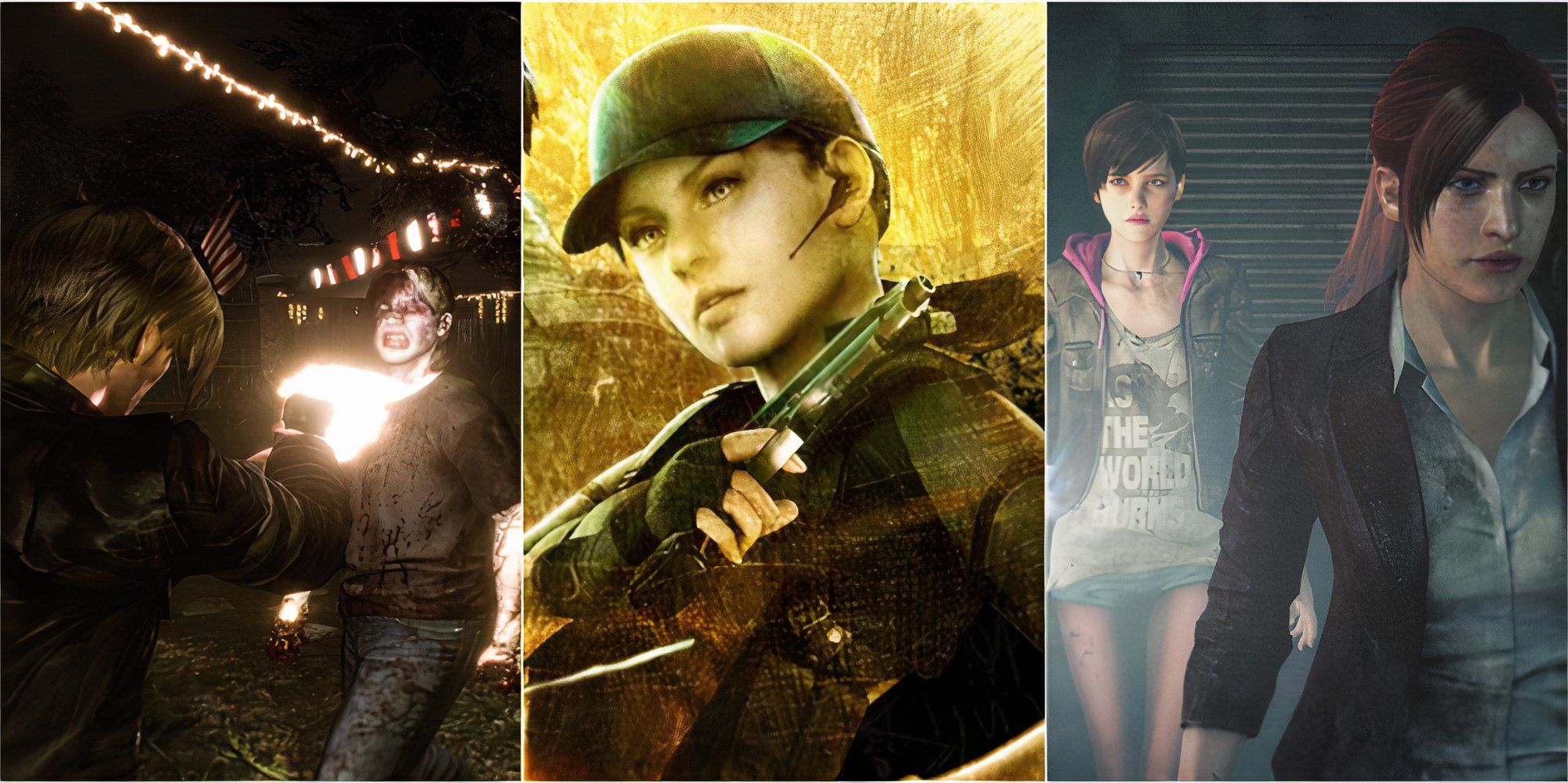Summary
- Umbrella Chronicles introduced a first-person view, adding a new perspective to classic stories.
- Village offered a more whimsical and fantasy-based aesthetic, unique to the series.
- The Mercenaries 3D created an entire game mode based on a popular bonus mode, which proved successful.
After ushering the survival horror genre into the mainstream, the Resident Evil games have often tried to stick to that original template, though not every entry has decided to follow the rules. Over the many years that this horror series has been running, Capcom has tinkered with certain core mechanics that drastically changed the gameplay formula for some entries.
6:54

Related
16 Best Resident Evil Games, Ranked
The Resident Evil series is expansive, housing some of the best action and horror games ever made.
Sometimes, this comes as an attempt to spark some life back into the series, or it was simply the developers catching onto an ongoing trend at the time. Either way, experimenting with the series has led to varying degrees of success, with these being some of the most unique and game-changing installments in the Resident Evil franchise to date.
8
Resident Evil: The Umbrella Chronicles
Umbrella Chronicles Implemented An FPS View So Players Could Experience Classic Stories From A New Perspective
Before there would be a Resident Evil 3 Remake, there was the Umbrella Chronicles, a game chronicling the events of the third and first game, along with Resident Evil 0. Unlike all the previous games which used fixed camera angles to add to the intensity of the gameplay, Umbrella Chronicles put players in the driver’s seat with an FPS view.
Considering the game was released in 2007, it makes sense why Capcom would decide to partake in the FPS craze, but it certainly paid off, so much so that a sequel would be released not long after. The recently released Nintendo Wii would be the perfect console for this game to release on thanks to the motion controls, making the experience all so immersive.
7
Resident Evil Village
Village’s More Fantasy-Based Aesthetic And Whimsical Nature Was Nothing Like The Series Had Seen Before
Resident Evil Village
- Released
-
May 7, 2021
- OpenCritic Rating
-
Mighty
Resident Evil Village ended up having a pretty ordinary vibe and aesthetic compared to the rest of the series. The game plays like a storybook, being a lot more magical and whimsical than anything seen in the series before. The appearance of a giant vampire lady or a man who can control metal, for example, seemed a lot more fantastical than what the series was used to, but that wasn’t necessarily a bad thing.

Related
7 Best Resident Evil Games With Little Or No Backtracking
Anyone who is a little put off by the amount of backtracking involved in the original Resident Evil games ought to try these entries.
In fact, this storybook charm really helps Village stand out as a unique game in the series, rather than just being yet another entry in Ethan’s journey. It’s uncertain whether Capcom will try and use this kind of aesthetic in future games, but considering how positively received Village was, it wouldn’t be an entirely bad idea to bring it back.
6
Resident Evil: The Mercenaries 3D
Capcom Based An Entire Game Around The Series’ Immensely Popular Bonus Game Mode
The Mercenaries had been an extra game mode in the Resident Evil franchise since the third game, but it had always been just that, a game mode. After it ended up becoming extremely popular though, Capcom made the decision to drop a standalone game for the 3DS entirely centered around Mercenaries.
This made the core gameplay loop entirely different, as players are tasked with gunning down as many enemies as possible to rack up a combo and unlock costumes for their favorite characters, which was all part of the main campaign. It was certainly a bit of a risk, but it ended up paying off given how popular the game would eventually become.
5
Resident Evil: Operation Raccoon City
Operation Raccoon City Bumped The Player Count To 4 And Introduced An Incredibly Unique Multiplayer System
Putting players in the shoes of an Umbrella operative, during the Raccoon City Incident no less, was the core idea of Operation Raccoon City. Additionally, this was the first game in the series that featured a full 4-player co-op mode, and though 2 player co-op had already been seen, bolstering the team members by an extra two led to an entirely different gameplay experience, one that leaned much more heavily into action.
While the campaign was therefore very unique in what it brought to the table, the game also featured a multiplayer mode where players of each team could choose from a cast of recognizable faces, like Leon, Jill, and HUNK, for example. Each character would have their own weapons and skills, resulting in what almost feels like a light hero-shooter. Operation Raccoon City ended up winning a lot of fans over for the risks it took, but not everyone got on board with its wild departure from its survival horror roots.
4
Resident Evil 6
Resident Evil 6’s Multiple Genre-Themed Campaigns Were Intriguing, But A Large Departure From What Came Before
- Released
-
October 2, 2012
- OpenCritic Rating
-
Weak
Multiple campaigns had never really been a thing in the series before, at least, not like they are in Resident Evil 6. In previous games, players could often expect to switch between two characters as part of the same story, like in Code Veronica, or could pick one of two characters to embark on their own adventure, but in the same environments, like the second game. Resident Evil 6, however, has four entirely different stories that all lean into a specific genre, whether it be horror, action, or even stealth.

Related
Resident Evil: 8 Most Immersive Games In The Series, Ranked
These Resident Evil games do an amazing job of immersing players into their nightmarish worlds.
The game also made it so two pairs of players could actually meet up in-game if their campaigns saw their characters crossing paths at a certain point in the story, which is a mechanic that no other game has even attempted since then. This multiple-campaign system wouldn’t end up becoming a mainstay in the series, but it certainly gave Resident Evil 6 tons of content to play and plenty of lore to learn.
3
Resident Evil Gaiden
Resident Evil Gaiden Feels Like A Game That Capcom Created As A Quirky Test Experiment
While Capcom had been gradually moving the story along with each mainline entry, they went in a slightly different direction with Gaiden. Resident Evil Gaiden plays out a ‘What if?’ scenario featuring the unlikely duo of Leon and Barry who have been stranded on a zombie-infested cruise ship.
While the camera angles somewhat mimic those of the classic games, the combat forces players into an FPS perspective where they must line up their shots with the correct timing, similar to the system Undertale would use many years later. Resident Evil Gaiden felt like Capcom was simply having fun and possibly experimenting with ideas and mechanics they would then replicate in the future.
2
Umbrella Corps
Umbrella Corps Went All-In With Its Action, Resulting In A Hectic Horde Mode
Resident Evil: Umbrella Corps feels like an experiment that went horribly wrong, which is quite ironic given how many times that’s happened in the series itself. Capitalizing on the immensely popular third-person action genre, Umbrella Corps is a run-and-gun kind of game where players aim to take down as many enemies as they can throughout numerous iconic locales from the series’ history.
This might sound similar to the Mercenaries, but it plays more like a horde mode where players must use their weapon abilities and character buffs to fend off endless hordes of zombies, Ganado, and Majini, rather than chasing them down, making it a little different. As mentioned though, Umbrella Corps would mark a low point for the series, even if some fans have started to warm up to it in hindsight.
1
Resident Evil 0
With No Item Boxes And Two Playable Characters On Screen At Once, Resident Evil 0 Took Some Pretty Big Risks
Resident Evil 0
- Released
-
November 12, 2002
After seeing much success with the first three Resident Evil games, Capcom decided to essentially break every rule in the Resident Evil playbook when it came time to develop Resident Evil 0. Item boxes were nowhere to be seen, meaning players would be forced to drop items or exchange them between their brand-new partner. The introduction of a second character works incredibly well, giving players the option to seamlessly move around both Rebecca and Billy with the thumbsticks.
Though co-op Resident Evil games are nothing new in the modern age of the series, 0 was the first time it would be implemented, or at least, tested as part of the gameplay loop. Resident Evil 0’s drastic changes would be met with mixed results from fans, but it certainly makes for a fresh experience that isn’t just a complete copy of what came before it.

Related
Resident Evil: 9 Biggest Traditions In The Series
These staples of the Resident Evil franchise are what give this series its identity, while also separating it from other horror games.















Leave a Reply